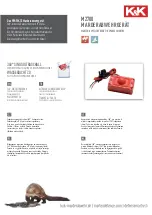
Instruction Manual
D200138X012
3582, 582i, and 3583
January 2013
31
Figure 16. Rotary Shaft Arm 0‐Degree and Case Index Marks, Location and Alignment
1
1
NOTE:
ALIGN INDEX MARKS AS SHOWN FOR MID‐TRAVEL POSITION.
A2452‐3
CASE INDEX MARKS
0‐DEGREE
ARM INDEX
MARKS
ARM AT MID‐TRAVEL POSITION
ACTUATOR STEM TRAVEL INDEXES
Calibration
WARNING
During calibration the valve may move. To avoid personal injury or property damage caused by the release of pressure or
process fluid, provide some temporary means of control for the process.
1. Shut off the supply pressure to the valve positioner. Connect or reconnect the necessary tubing from the valve
positioner output to the actuator supply connection. Connect the input to the valve positioner and set the input
signal value at midrange.
2. Move the flapper assembly to approximately position 6 in the proper operating quadrant of the beam (direct or
reverse acting), and apply supply pressure to the valve positioner. The 0 degree index marks on the rotary shaft arm
should align with the case index marks as shown in figure 16 and the actuator should be at its midtravel position. If
not, first check for loose linkage or improper cam installation. A minor nozzle height adjustment might be
necessary to make the desired input signal value correspond to the starting point of travel.
3. Apply an input signal equal to the low value of the input signal range. For example, for a 3582 valve positioner with
a 0.2 to 1.0 bar (3 to 15 psig) input signal range, set the input signal at 0.2 bar (3 psig). Loosen the nozzle locknut
and adjust the nozzle until the actuator moves to the proper end of its travel. Changing the nozzle position is
intended only as a means of zero trim adjustment. Whenever nozzle position is changed, the zero reference point is
changed.
4. Apply an input signal equal to the high value of the input signal range and observe the actuator stem travel. If the
stem travel is short of its expected range, increase the travel by moving the flapper assembly to a higher number on
the beam. If the desired stem travel occurs before the input signal reaches the high value of the input signal range,
decrease the travel by moving the flapper assembly toward a lower number on the beam.
step 3 to provide proper zero.
Moving the flapper assembly toward zero on the beam scale decreases stem travel. Table 11 lists the minimum
stem travel available for different travel pin settings. For example, with a travel pin setting of 2 the minimum stem
travel possible, for the full input signal range, would be 11 mm (0.4375 inch).
















































